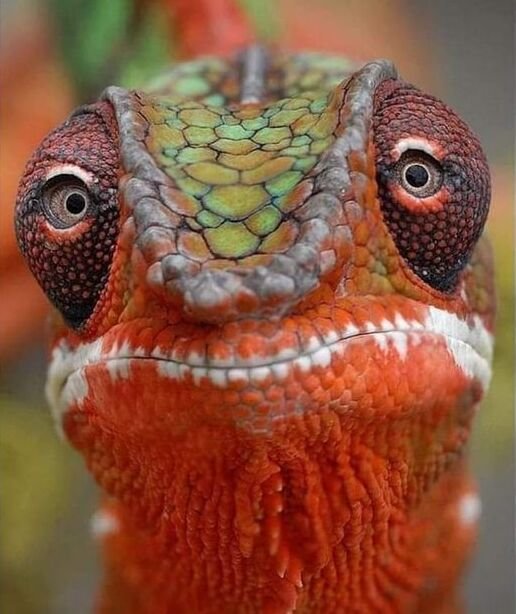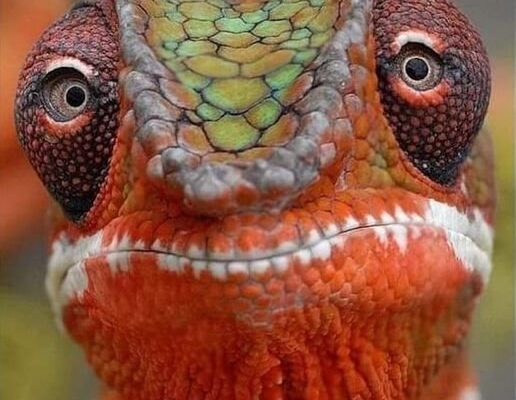
Let’s dive into why chameleon eyes move this way and what makes this creature so special. It’s not just a party trick; it serves some serious purposes that are essential for their survival.
The Mechanics of Chameleon Eyes
Chameleons have some of the most advanced eyesight in the animal kingdom. Their eyes can move in almost any direction independently, a bit like the way a panoramic camera captures a wide view. Each eye can swivel while the other focuses on something completely different. This ability allows them to keep an eye out for predators while also looking for tasty insects—talk about multitasking!
The structure of their eyes is quite interesting. Chameleons have a unique lens and retina that enable this independent movement. Each eye is housed in a bony socket, allowing it to pivot. This flexibility is what gives them such a wide field of view. Typically, chameleons can see a full 360 degrees around them, which is a big advantage in the wild.
Evolutionary Advantage: Why It Matters
You might be wondering why this eye movement developed in chameleons. Well, it’s all about survival. Chameleons are often prey for birds and other predators, so being able to scan their environment without exposing themselves too much is critical. By keeping an eye on predators while searching for food, they increase their chances of survival.
This independent eye movement also aids in hunting. Chameleons have excellent depth perception, which helps them judge distances accurately when catching insects with their long, sticky tongues. This eye coordination is essential for successful hunting and is a big reason why chameleons are such effective predators in their habitats.
How Chameleons Use Their Eyes to Communicate
Chameleons don’t just rely on their unique eyes for hunting and evading danger. They also use their eye movements as a form of communication. When threatened, a chameleon may display its colorful skin patterns while focusing its gaze on the perceived threat.
For instance, a male chameleon might use eye movement to signal to a potential mate or even warn off rivals. This behavior can highlight their fitness and readiness to mate, which is crucial for their reproductive success. So, their eyes aren’t just for seeing—they’re also a powerful tool for interaction.
The Science Behind Independent Eye Movement
Here’s the thing: the way chameleons move their eyes independently isn’t just fascinating; it’s also quite complex. A chameleon’s brain has specialized areas that coordinate eye movement. The *optokinetic reflex* allows them to track moving objects smoothly while keeping their head still.
Studies show that chameleons can switch from one eye to the other quickly to focus on different objects. This unique brain structure is what allows their eyes to work together but independently at the same time. Imagine having a smart device that could alert you to different notifications simultaneously—that’s similar to what a chameleon’s brain can do with its eyes!
Comparing Chameleon Eyes with Other Species
While chameleons have mastered independent eye movement, they’re not the only creatures with interesting eye mechanics. Some species of frogs and certain types of birds also have impressive eye movements.
Let’s compare a few:
| Animal | Eye Movement | Purpose |
|---|---|---|
| Chameleon | Independent movement | Hunting and predator awareness |
| Frog | Fixed positioning | Buffering against predators |
| Owl | Non-movable eyes, rotating head | Night vision and hunting |
As you can see, each species has adapted its eye movement for specific environments and survival tactics. Chameleons are unique in how they can look in two different directions, helping them thrive in their niche.
Chameleon Eyes in Captivity: What’s Different?
If you’ve ever thought about keeping a chameleon as a pet, you might be curious about how their eye movement works in a controlled environment. In captivity, many chameleons can still move their eyes independently, but their behaviors may change in response to their surroundings.
Having limited space can cause stress for these animals. When in captivity, they may not feel the need to keep their eyes on as many threats, but their incredible sight still remains. It’s important for pet owners to create an environment that mimics their natural habitat as closely as possible, helping to keep these fascinating creatures healthy and happy.
Chameleon eyes are more than just a quirky trait; they are a stunning example of evolution finely tuned for survival. Their ability to see independently offers them the advantage of hunting efficiently and staying safe from predators.
Next time you see a chameleon, take a moment to appreciate those incredible eyes. They remind us of the wonders of nature and how diverse life can be—all while being the ultimate multitaskers. So, whether you’re a nature lover or just curious about the animal kingdom, chameleons and their remarkable eyes have much to teach us about adaptation and survival.

